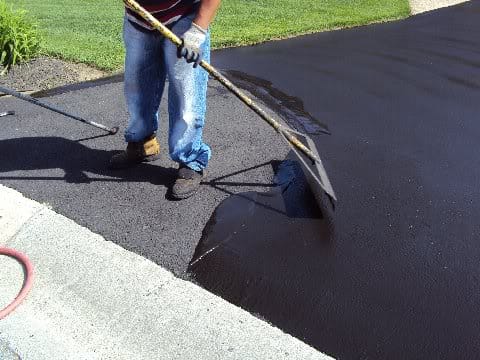Unleash the Possible: Regrading and Asphalt Sealing for Business Rooms
Unleash the Possible: Regrading and Asphalt Sealing for Business Rooms
Blog Article
Warm Mix Asphalt: A Lasting Solution for Sidewalk
Warm Mix Asphalt (HMA) has actually become a leading sustainable option for pavement solutions, providing a myriad of ecological advantages and innovative innovations. Its capability to reduce and reuse products energy usage presents a compelling instance for its fostering in road building projects. Moreover, the long-term efficiency and durability of HMA make it a recommended choice for facilities development. As the demand for environment-friendly building practices grows, discovering the subtleties of HMA's sustainability can supply important insights right into the future of pavement solutions.
Environmental Advantages of Hot Mix Asphalt

Additionally, Warm Mix Asphalt helps to alleviate urban warm island effects. Its dark color soaks up sunlight, minimizing the amount of warm mirrored back into the ambience compared to lighter-colored pavements. This can reduce ambient temperatures in metropolitan locations, decreasing the demand for air conditioning and ultimately minimizing power consumption.
Additionally, Hot Mix Asphalt adds to boosted stormwater management. Its porous nature allows water to charge and penetrate the sidewalk groundwater products, reducing runoff and the risk of flooding. These environmental benefits make Hot Mix Asphalt a sustainable choice for paving highways and roads.
Energy Effectiveness in HMA Production
Is energy efficiency a crucial variable in the manufacturing of Hot Mix Asphalt (HMA)? Power plays a considerable role in the manufacturing of HMA, affecting both expense and ecological sustainability. One crucial facet of energy efficiency in HMA manufacturing is the use of cozy mix asphalt (WMA) innovations.
Furthermore, improvements in plant technologies have led to even more energy-efficient HMA manufacturing processes. By enhancing power use in HMA production, the market can lower its carbon footprint while maintaining top notch sidewalk materials.
Recyclability of Hot Mix Asphalt
The recyclability of Hot Mix Asphalt (HMA) is a crucial facet of its sustainability and long-term environmental effect. HMA is just one of one of the most recycled materials in the United States, with over 100 million heaps of redeemed asphalt sidewalk (RAP) being reused yearly in new pavement building. Reusing HMA supplies several environmental benefits, such as decreasing the requirement for virgin products, reducing power intake throughout manufacturing, and lowering the quantity of waste sent out to land fills.
The procedure of recycling HMA involves crushing the existing sidewalk, crushing it right into smaller sized pieces, and mixing it with brand-new aggregate and asphalt binder to create a recycled mix. On the whole, the recyclability of HMA plays a significant function in promoting lasting methods within the pavement sector.

Long-Term Efficiency of HMA
Asphalt sidewalks show resilience and durability over a prolonged period, showing the long-lasting performance of Hot Mix Asphalt (HMA) The longevity of HMA can be attributed to its ability to endure try this site heavy traffic loads, Bonuses harsh weather conditions, and the effects of aging. Studies have actually shown that well-designed and correctly built HMA sidewalks can last for two decades or more with regular upkeep. The key to making best use of the long-term performance of HMA hinges on making use of top notch products, complying with ideal practices in building and construction, and carrying out efficient maintenance strategies. Correct drain, routine inspections, and prompt repair work are vital for preserving the architectural stability of HMA pavements with time. Furthermore, developments in HMA technology, such as making use of polymer-modified binders and warm mix asphalt, have further boosted the toughness and durability of HMA pavements. By focusing on quality building and construction and maintenance practices, HMA remains to verify itself as a sustainable and cost-effective remedy for resilient pavement facilities.

HMA: Toughness and Sustainability
Demonstrating both durability and sustainability, Warm Mix Asphalt (HMA) has ended up being a cornerstone in the building and construction of lasting sidewalk facilities - commercial parking lot paving. HMA's sturdiness stems from its capability to hold up against heavy lots, severe weather, and high web traffic quantities, making it a reputable choice for streets, highways, and airport terminal paths. The make-up of HMA, which normally includes aggregates, binder, and filler, plays an important duty in enhancing its durability and resistance to tear and wear
Additionally, HMA's sustainability hinges on its recyclability and energy-efficient production process. The capacity to recycle reclaimed asphalt pavement (RAP) in brand-new HMA combinations reduces the demand for virgin products and decreases the ecological impact of pavement building and upkeep. In addition, the power efficiency of creating HMA depends on its reduced blending temperature levels contrasted to other pavement materials, resulting in minimized power intake and greenhouse gas exhausts.
Conclusion
In final thought, hot mix asphalt (HMA) supplies a lasting service for pavement with its eco friendly characteristics. HMA's recyclability, power effectiveness in production, and lasting sturdiness make it an environmentally friendly choice for roadway building.
HMA is one of the most recycled products in the United States, with over 100 million lots of reclaimed asphalt sidewalk (RAP) being reused each year in new sidewalk construction.The procedure of recycling HMA entails crushing the existing pavement, crushing it right into smaller sized items, and mixing it with brand-new accumulation and asphalt binder to develop a recycled mix.Asphalt sidewalks demonstrate resilience and strength over a prolonged period, showing the long-term performance of Warm Mix Asphalt (HMA) Additionally, innovations in HMA innovation, such as the usage websites of polymer-modified binders and warm mix asphalt, have actually further improved the durability and durability of HMA sidewalks. The ability to reuse redeemed asphalt pavement (RAP) in new HMA combinations reduces the demand for virgin products and minimizes the environmental effect of sidewalk building and upkeep.
Report this page